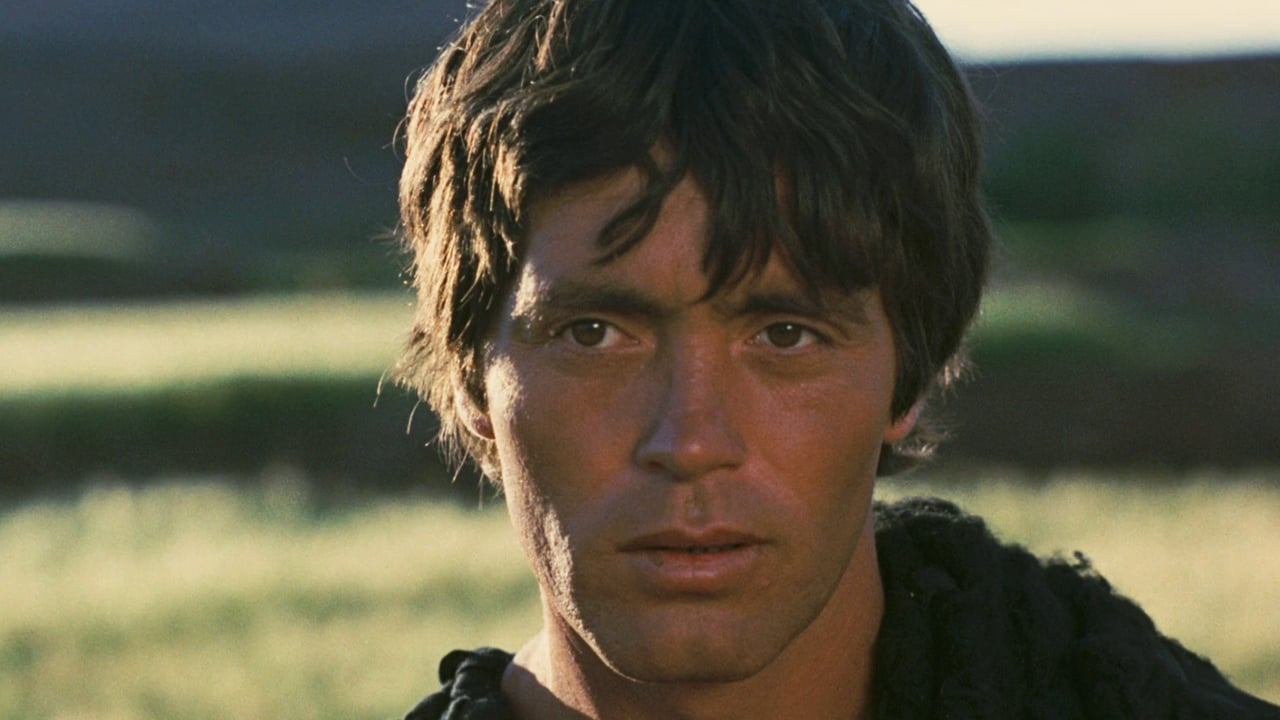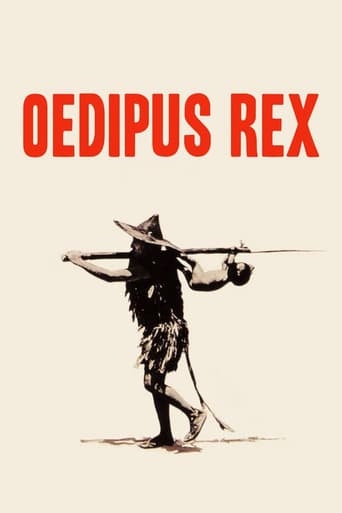

Pier Paolo Pasolini's Oedipus Rex is a relatively faithful adaptation of Sophocles' Greek tragedy Oedipus the King. Beginning in 1920's Italy, a baby boy is born and is instantly envied by the displaced father. The setting then changes to ancient times, where a baby boy is being carried out into the desert by a servant to be left out to die from exposure. He is eventually picked up by a shepherd, who takes him back to the King and Queen of Corinth, who adopt the youngster and love him like one of their own. The child grows up to be Edipo (Pasolini's frequent collaborator Franco Citti), an arrogant youth who wishes to see the world for himself. And so he set out on the road to Thebes, the place of his birth.Plagued by a prophecy that dictates he is destined to murder his father and marry his mother, Edipo is a tortured but intuitive soul. He murders a rich man and his guards after they demand he clear a path for them on the road, and later frees a town from the clutches of a Sphinx by solving its riddle. Staying true to his own recognisable style, Pasolini tells the story of Oedipus not with a sweeping narrative, but through a collection of comedic, violent and often surreal vignettes, the most bizarre and ultimately thrilling being the scene in which Edipo murders the guards. He runs away from them as they chase him, before charging at them one by one and cutting them down. It's a moment without any real motivational insight, offering but a glimpse into Edipo's damaged psyche.Post-Freud, the story of Oedipus cannot be experienced without reading into the incestuous and patricidal undertones. But these themes are less explored by Pasolini than the idea of Edipo being ultimately responsible for his own downfall. Rather than the inevitability of fate, Edipo creates his own path, committing murder on a whim and marrying while blinded by ambition. For a bulk of the film, Pasolini keeps the audience at arm's length, favouring his own brushes of surrealism over a traditional narrative. While this may be occasionally frustrating - the pre-war scenes than book-end the film seem out of place and confusing - Citti's wide-eyed performance is a fantastic distraction, and the Moroccan scenery helps provide a ghostly, Biblical atmosphere as well as a beautiful backdrop.
... View MoreThis tale of Oedipus starts off and ends in the twentieth century, though for the most part is set in a primitive version of ancient Greece. There is not much rational connection between the stories, but Pasolini manages to forge himself a free pass on that one. Whilst the Oedipus Complex theme of the first story is meant to be taken quite literally, and is basically autobiographical, the middle story, recognisably Sophoclean, is more, in my opinion, meant to be about an angry confused man who cannot stomach his fate nor confront truths about his identity. As both sections do genuinely feel autobiographical they knit together just fine.The first section of the film set in the 1920s is the best piece of filming I have seen from Pasolini and made me really excited. There's a wide open scene of children running off around a playing field on a hot piercing day, one of those thick childhood days when the emotions battened down the hatches on squire intellect. I was reminded very much of an Edith Sitwell poem (Green Flows the River of Lethe - O): "I stood near the Cities of the Plains / And the young girls were chasing their hearts like the gay butterflies / Over the fields of summer - / O evanescent velvets fluttering your wings / Like winds and butterflies on the Road from Nothing to Nowhere!" The sentiment all the more surprisingly apt given that the second part of the film is shot in what could be the ruins of Sodom and Gomorrah (the Cities of the Plains) for all we know.The rage of Oedipus, which occurs frequently in the movie could be liked to another part of the poem: "But in the summer drought / I fled, for I was a Pillar of Fire, I was destruction / Unquenched, incarnate and incarnadine // I was Annihilation / Yet white as the Dead Sea, white as the Cities of the Plains / For I listened to the noontide and my veins / That threatened thunder and the heart of roses." Part of Pasolini's drive for shooting the films seems to be to continue his fascination with ancient buildings and ruins which he demonstrated three years earlier in his superb 1964 documentary The Walls of Sana'a for which he travelled to Yemen.The end of the playing field scene features Jocasta suckling Oedipus. She gazes directly at the camera and thus the audience for a long period, in which she goes through a range of emotions, including what could be arousal, followed by disquiet, which ultimately turns into a distanced understanding. For me this is cinematically equivalent to the Mona Lisa, which is also a gay man's meditation on his mother, greatly cryptic yet provocative, set in against a natural backdrop.Silvana Mangano, who plays the mother in both parts of the movie (and would star in Pasolini's Teorema the following year), carries a lot of it. Her beauty, her alabaster skin and wispy eyebrows, her perfectly tangled plaits (which would send Fuseli to his knees), are commanding. She has an artistic skill that eclipses that of Franco Citti (Oedipus) and Ninetto Davoli (Thebes' crier) quite totally. Franco Citti's lack of skill, whilst occasionally infuriating in the context of the story (his is not the demeanour of a king) do however lend the film a level of authenticity, given the primary motive of this sequence, which was to demonstrate a pained adolescent fury and denial, which was ignorant at its base.There's an unusual device of writing characters' thoughts in black lettering on a white background, which doesn't quite work but which would be far better than the presumable alternative of camera-faced soliloquies.Some of the locations in the movie felt truly dream-like to me, for instance the unkempt walled piazza-garden of Jocasta, the crumbled ruin where Oedipus meets a naked adolescent girl on his peregrinations, the mountainous areas between cities.The props in the movie are cheap and fantastical but quite brilliant, the wind-blown hands on the milestones to Thebes, the quite bizarre head gear of the Pythoness, the soldiers, and King Laius. Modern producers who delight in throwing money at movies, please note how Pasolini achieves far better results with great economy.Cultural references abound, my favourite being the Japanese music, which doesn't seem to have been referenced anywhere (there are no closing credits in the movie), but sounded very much like the Toru Takemitsu scores of Ansatsu (Assasination), Woman in the Dunes, and Harakiri.The story in a strict narrative sense has problems, Citti doesn't convince as any type of king or warrior, giving the appearance of not understanding his lines at some points, and the suicide of Jocasta makes no sense in the wake of her discussions with her son. It is a movie where feeling rather than thinking brings greater rewards.
... View MoreLike in other Pasolini movies, we have here two parallel told stories: There is a first "Oedipus", in the 20ies of the 20th century, a baby is nursed by his beautiful mother, sitting on a meadow. His father is afraid that the baby will steal his love. Then there is the second "Oedipus", based on Sophocles, but very freely interpreted by Pasolini, both what concerns the landscape (Southern Italy, Maroque) and the costumes, as well as the original texts (Pasolini shows parts of "Oedipus on Kolonos"). Otherwise, we are told here the mystic story of Oedipus, who is left by his parents, grows up with the king of Korinthos, gets to kill his father and to marry his mother, being fully unaware of what he is doing: he is doomed. At the end, the first Oedipus is coming back: As a blind beggar (the mystic Oedipus was blinded on his own wish) he sits in front of the cathedral of Bologna, is accompanied by a young boy and seeks that meadow where the movie started."Edipo Re" (1967) is one of those films by P.P. Pasolin about which we have extensive comments by the author and film director. Pasolini considered this film autobiographic, being himself that baby on that meadow suckling the milk from his beautiful mother's breast and causing unintentionally his fascist-fathers hatred. He made himself responsible for the death of him whom he loved and hated at the same time. Also, in this picture, there is the complicated relationship of the gay-man towards his mother which Pasolini called "latent". Pasolini wrote that he intended a completely metaphorical and mysticized autobiography, but instead of projecting the myth onto psychoanalysis, he would project psychoanalysis on the myth. So, there is only to say that we know Pasolini's mother Susanna from several of her son's movies in which she played minor, but often crucial roles - in the "Gospel according to St. Matthew" she was the old Marie ... .
... View MoreSophocles' Oedipus Rex is adapted well for the foreign screen. Pasolini, better known for the controversial Salo; 120 Days of Sodom, has kept the intensity level to a minimum while still presenting the perverse qualities for which he would be known for. If you don't know the story (like who doesn't) read the play before seeing the movie - there tends to be a shortage on literature freaks these days. Beautifully filmed, Oedipus Rex begins in modern times, continues sometime BC, and finally ends back in the 20th century; thus presenting a sociological thesis for the viewer. The acting is a bit hammy (seeing Oedipus with a mad streak can be over the top) although the characters are developed well and recite their lines as if on stage. My only complaint is the subtitles seem to blend in with the scenery --- white subtitles against a white background. Therefore, this flaw makes it difficult to enjoy some scenes, and Pasolini's poetry is usually superb. Nevertheless, it's still a great film and is worth a look, especially by people with preconceived hatred for Pasolini's later work -and there's definitely a lot out there.
... View More